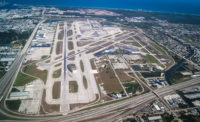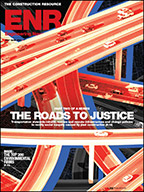In response, transportation officials, University of Minnesota researchers, and the design-build joint venture of Flatiron Constructors Inc. and Manson Construction Co., with lead designer Figg Engineering, studded the bridge with 323 sensors in spans, piers and abutments. The sensors, part of a $1-million-plus structural health monitoring system, produce data on how the overall bridge and its components respond to loads, vibrations and temperature changes. The data is used to monitor performance and validate design criteria and assumptions.
Because the bridge is still relatively new, the already massive volume of data has yet to spur changes in bridge design, construction or maintenance. Data is used to validate several cylinder-based test models for predicting concrete creep and shrinkage.
“The predicted creep and shrinkage varies substantially among these models,” explains Carol Shield, a civil engineering professor at the University of Minnesota.
She is studying the data and design standards established by the American Association of State Highway Transportation Officials, the American Concrete Institute and the model code of the Euro-International Committee for Concrete (CEB). “What we see in the bridge [thus far] is larger amounts of creep and shrinkage than what would be predicted by AASHTO and ACI but less than what would be predicted by CEB [and other models].” She notes that Figg used a CEB model.
“Few bridges are instrumented like this one,” Shield adds. “Usually, an existing bridge is monitored for maybe a year. This is a test bed.”
Other high-profile bridges recently built with technology for long-term structural health monitoring are the replacement for the I-10 Twin Spans Bridge in New Orleans, famously taken out by Hurricane Katrina in 2005, and the I-495 Woodrow Wilson Memorial Bridge over the Potomac River just east of Washington, D.C. The Wilson bridge opened in 2006 with a pilot project for the long-term structural health monitoring of piers. Smart Structures Inc., West Palm Beach, Fla., provided the technology. “Our specialty comes from putting the instrumentation inside the concrete of the prestressed structure,” says Sastry Putcha, vice president and technical director.
Prior to pile-casting, instrumentation packs—with accelerometers, tilt and strain gauges, and temperature sensors—are fastened to reinforcing steel and tendons near the pile tip and at other elevations. The packs are wired to a wireless transmitter at the top. The sensors share the life of the pile, from curing, shipment and driving to construction and load-bearing service.
The real-time data is used to ensure quality and optimize driving. Sastrey says changes in static, prestressed loads and pile behavior can signal damage. Damage ranges from micro-fracturing and fissures and corrosion to abrupt stress shifts, which can signal a pile fracture deep in the ground. The data from all the piles in a bridge or all the piles in a portfolio of bridges can feed monitoring software in the cloud.
The system was developed over the past 15 years at the University of Florida in partnership with the Florida Dept. of Transportation. It was licensed to Smart Structures. More than 3,000 piles have been driven with it in Florida, with more in the Carolinas, Virginia and Maryland. But despite its capabilities, it is almost never used for long-term monitoring. The company sold this spring to Radise International, one of its technical partners, says Kumar A. Allady, Radise president.
“Most of the 3,000 piles were all short term,” says Allady. “You drive the pile, you get the capacity, and you stop.” He says users like the system for optimizing driving and test piles, but long-term monitoring has lagged behind because it is not clear who should pay for it. He aims to broaden the system’s market beyond U.S. transportation.
Prior to the sale, Kurt Hecht was engineering manager on the founding team. He believes the tool was ahead of its market—and still is, but now less so than before.
“When you leased a workstation, you got an account on the cloud, and you could monitor your data on all your piles on all your bridges. We built the whole ‘internet of things’ for construction—we built it, and nobody came,” he says.
“It will become a reality,” Hecht adds. “It’s a question of when. Federal highway officials need to step up and say, ‘This is in the best interest of everybody.’ ”













Post a comment to this article
Report Abusive Comment